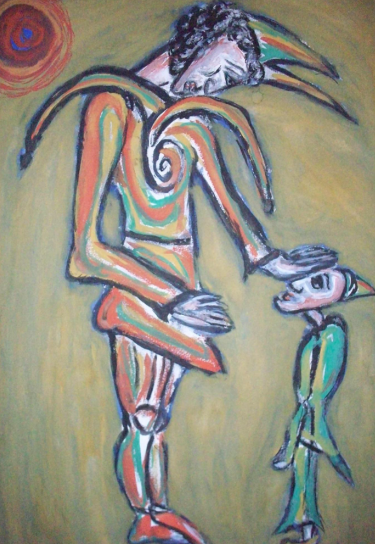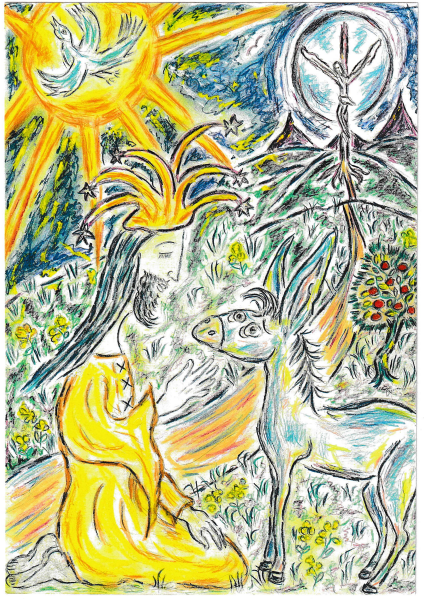
Little Big
By Lanechka Fevola
“A Fool who persists in his folly will become wise.”
“Poetry, Painting and Music, the three Powers in Man of conversing with Paradise…”
William Blake
“A song forever on her tongue, in the loneliness of a gentle breeze, she tasted the equinoctial rhythm of the year, her lungs deeply drawing in an unknown yearning. It was all so unexpected. Had she travelled a great distance? Well, her dress seemed to think so. At least the loosened threads that held what they could of it together, were a testament to the fact, especially after what the moths had done to it. Sweet winged things, they were only curious creatures who had wanted to feed on finery laced with the traceries of a wonder, a wonder that was truly Eve’s.”
This is from a story I wrote some years ago, about a Fool’s experiences in a city on April Fools Day. I have always been fascinated by fools and clowns, court jesters, mimes and troubadours. I had a collection of fool and clown dolls, particularly that of the character of Pierrot. I had also done drawings of fools and clowns and made my own puppets of the characters from the Commedia dell’ Arte, and performed with them in theatre projects created with my partner. I had also been in a clown troupe.
I loved Pierrot’s beautiful, soulful face, tinged with melancholy which seemed to come from a longing for another world, a world unto itself, that of the soul, full of dreams and thoughts, and inhabited by extraordinary beings, or, who were perhaps, really states of being. When great actor/mimes played him, such as the wonderful Marcel Marceau, as his character, Bip, and Jean Louis Barrault in the french film, Les Enfants du Paradis, their gestures and movements spoke a language to me. It seemed a way of “conversing with Paradise,” to use Blake’s phrase, for they were seeing the world with the eyes of imagination.
It is a very real world, some might call it Paradise, some Eden, and those of us who have had even just a glimpse of it, feel that that they have always known it, for that world is always present within us, yet, somehow, it had been forgotten and lost to us. And once experienced, yearn to return to it. The poet, Kathleen Raine, once wrote that this world was “the interior country of the human imagination, where rivers and mountains and stars, sun and moon and seas, trees and birds, exist not as natural objects but as imaginative experiences.” This quote was taken from her essay about the paintings of the British artist, Cecil Collins, who painted Fools and Angels as archtypes of the imagination. To him, the Fool was a Being of innocence with a great heart, full of light, humour, joy and gaiety. It was an innocence that kept his heart open to the flow of wisdom and joy coming from that sacred source. But, still, he carries with him a sorrow, a kind of wounding, as he traverses the natural world, whose harsh society, dominated by an emphasis on technology and logical analysis, does not value his gifts, whose priorities are not beauty and wisdom, truth and goodness, but are more about material gain and fast living, a society, alienated from nature, which tends to see things in quantitative terms. This kind of society is not creative, for it is interested more in excessive manipulative, exploitative power, not ethical, creative power. Therefore, the Fool is looked upon with scorn, treated as a misfit or “idiot,” and, thus, misunderstood, ignored, exiled to a kind of madness, and trampled upon. To the Fool, time is not money, as it is in the everyday world of our consumer society, for he lives in a timeless world. He takes part in the art of leisure. The Fool will look with reverence at a tree or a star or a butterfly. He experiences the wonder that is a bird, its beauty or “suchness,” a creature that revels in being itself. It cannot help but sing when the dawn comes. That is its joy. And the Fool is in communion with it. Cecil Collins said that “the Fool is the poetic imagination of life, as inexplicable as the essence of life itself.” His Fools are Holy Fools.
When I first saw his paintings, I was very drawn to them and to his world of magic and wonder so filled with a Divine Presence. I was touched by their poetry made powerful by a simplicity and sensitivity full of depth. I felt at home in this world , the same way I felt at home in the world of the artist, Marc Chagall, whose work had a unique dreamlike quality, painted with a deceiving childlike simplicity.
Eve’s dress had a sensitive, changeable nature, “that if you touched a bit of hem or sleeve, you could but watch the fabric flinch like a water lily from a cold wind and close up completely, or flutter like a butterfly on sensing a heartbeat and flit as a stirred up emotion or mood whether happy or sad… Colours changed colour. The sleeves, for instance, were a most particular blue. Oh, not just any blue. Some might call it melancholic, some heavenly; others tragic. How it would splash itself around in variable hues of that mystical colour to find its true nature, and stretch so very long with longing, especially when Eve tried to reach for the stars, or, when searching lowly places, meandered as long as winter nights, shivering all the way along her arms down to the wrists to where they were cuffed in a fluffy, swooning violet lace-work, so that her hands could gesture in a most poetic fashion.”
My character, Eve, had that “strange” funny way about her. She lived in that beautiful world of the imagination, and seemed to be always in conversation with Paradise. Walking was one of her passions, and she would carry around with her a big shopping bag full of the curiosities of her own world, like a baglady, such as an antique bird cage that doubled as a cuckoo clock, that would let her know when it was time for her to sing a song. The bag was covered with labels of each city that she had visited, for she was just a visitor, a kind of messenger. And these labels formed pictures, creating colours and images like those of fabulous birds and flowers.
“She didn’t really know where she was going though she did have a vague feeling. Still, she was somewhat happy today, her ears finely-tuned to the ringing bells of St. Mary’s Church. But had the sky noticed? Yes, for it had blessed her with a fine day. When tears came it always rained. When her heart sank, there was nothing but grey. And there would have to be the appropriate music to accompany her. You see, Eve’s heart was a violin. Music gave her life a heart-broken theme with variations of a kind you might find in a silent film, and this life seemed to invent itself as it went along.” Though the world of the imagination is always present within us, the soul must make the journey into the heart of that inner landscape, into deep mystery. And, because it is always present, once there, even if for just a brief moment, we can, then, look upon the natural world with eyes inspired by beauty and wonder and experience nature as a shining, sacred presence.
On her walks, she would, somehow, always manage to get a small pebble lodged at the bottom of one of her winkle-picker booties, which was a constant reminder of her own wound of loneliness caused by her being an outcast. She was called Eve for that very reason. Her dress torn by the sorrows of the world “swept wild down her slender-stockinged legs in trails of variegated dream that brushed the stone pavements clear with a tender sigh as she walked.” Eve, too, is a Holy Fool.
I would say that Jesus was a Holy Fool, as was St. Francis and St. Bernadette, extraordinary, visionary spirits, who were misunderstood and wounded by their cynical societies and made to suffer. Yet, the essence of who they were remained untouched, their inner being protected by what Cecil Collins called “The Great Happiness.” He said, “The Fool is the Christ in everyone, a quality we negate or destroy at our peril…, and who in an ecstasy of happiness bows down with his gay garments, down into the dust, with a humility that touches the bottom of the abyss of life…!” True wisdom can seem like folly to those who cannot go beyond conventional thinking or belief. The Fool may travel through the ways of the natural world, but he or she has transcended them.

The Resurrection
By Lanechka Fevola
Eve encounters a Priest in St. Mary’s Church. He is preaching to an absent congregation, imparting a message he had received in a dream from an Angel, telling people that today, April 1st, the Feast of Fools, “we must open the temples of our hearts, open them like flowers to the sun. For this bright day is a Holy Day, the Soul’s Day.” He tells them to become poets and forge dreams out of Love’s flame…,” to “dance, sing, laugh and cry.” He is telling them, to open up, in celebration, their hearts in innocence, to the Fool’s timeless wisdom; to tie up the gifts of love, wisdom and wonder, “in little bows and bells,” and present them to others, particularly those in need, the poor, the sick, the lonely, to help awaken the Fool in everyone. I think it would be wonderful to make All Fools Day a holiday as Cecil Collins had advocated in his beautiful essay, “The Vision of the Fool.”
Eve longs to to something special, to share this happiness with others as she journeys forth through the time-bound natural world, where she leaves an eternal footprint, and into the mysterious unknown. Cecil Collins ends his essay by saying, “The Saint, the Artist, the Poet and the Fool, are one. They are the eternal virginity of spirit, which in the dark winter of the world, continually proclaims the existence of a new life, gives faithful promise of the spring of an invisible Kingdom, the coming of light.” Let us usher in the spring with joy, love and compassion, open our eyes with wonder, and lift our hearts with laughter and song, and celebrate the Fool in all of us..
